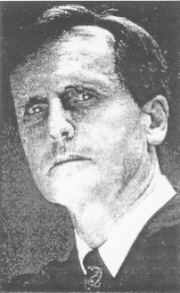

|
|
Lubomyr Prytulak Ukrainian Archive, www.ukar.org [Address] [Telephone] [Email] 09 December 2002 |
|
We also agree with the district court's conclusion that remittance of a filing fee is not jurisdictional and that the clerk should have accepted McDowell's complaint despite his failure to submit a filing fee or request IFP status. Although a complaint is not formally filed until the filing fee is paid, we deem a complaint to be constructively filed as of the date that the clerk received the complaint � as long as the plaintiff ultimately pays the filing fee or the district court grants the plaintiff's request to proceed in forma pauperis.
McDowell v Delaware State Police, 88 F3d 188 at 191 (U.S. Court of Appeals, Third Circuit, 1996). |
|
Sheriff's officials said they released Espino because they could find no records in their inmate management system showing that he was being held on any other charges or warrants. Sheriff's officials, in an announcement last weekend, said they discovered that Espino was a murder convict only after receiving a tip July 18 from an anonymous caller asking why Espino had been released after his conviction. The sheriff went on to cite "a courtroom paperwork error" stemming from the fact that Espino had been tried for murder, without the department's knowledge, in Juvenile Court last year. [...] However, court officials, prosecutors and court records have made clear this week that Espino's murder trial actually took place beginning late last month before Superior Court Judge James R. Dunn, at a time when the defendant was in the custody of the Sheriff's Department. Sheriff's officials, who say that they are continuing to investigate the circumstances involving Espino's release, refused to concede until late Tuesday � after receiving a fax from The Times of a publicly available court record detailing the jury's verdict � that Espino's murder trial had even taken place this year. "This was not in our possession and never has been," said sheriff's spokesman Ron Spear of the document, known as a "minute order." "I don't doubt the piece of paper you sent me is truthful. We have nothing sent to us from court indicating he was convicted of murder." Espino is at least the 14th County Jail inmate erroneously released by the Sheriff's Department this year, the department acknowledged. In 1995, the sheriff mistakenly released 14 prisoners in the entire year. [...] Although any erroneous release is disturbing, a leading watchdog of the law enforcement system says the number is tiny in light of the tens of thousands of prisoners processed each year by the department. "When you look at the entire system, the numbers are minuscule compared to the number of people who flow in and out of the jails on a daily and yearly basis," said Merrick J. Bobb, a Los Angeles lawyer who serves as special counsel to the sheriff on implementing departmental reforms. Bobb, though, said the sheriff's system of tracking inmates does merit a fresh look. "I'm very interested in gaining an understanding of the system for classifying, sorting and tracking inmates," he said. "One of the things I'm interested in looking at is the interaction between the court system and the Sheriff's Department." [...] Sheriff's officials, who say that Espino was transferred to their custody from Juvenile Hall in December, contend that the first step in the breakdown occurred because they were never informed by juvenile officials that the young defendant faced anything other than robbery charges. Even if Espino were cataloged incorrectly at that time, questions persist as to why the sheriff's jailers never learned the reason they were repeatedly transporting Espino to Judge Dunn's courtroom, the site of the murder trial, while in their custody this year. Spear said written court orders known as "removal orders" calling for Espino's appearance in Department 119 "did not indicate what the charge was." [...] Superior Court Judges Dunn and Patricia Collins, who handled the robbery case, both refused Wednesday to comment on the mistaken release. Paul Feldman, Records Rebut Sheriff's Version of Killer's Release; Law enforcement: He was in department's custody before and during trial, they show. Officials say they didn't know about murder case when they freed him, The Los Angeles Times, 25-Jul-1996. Bold emphasis added. |
|
Los Angeles County Cases Perhaps nowhere have the results of poor communication between jail and court information systems been better documented than in Los Angeles County, California. This system is one of the busiest in the country. As of 1996, about 2000 inmates arrived at the jail from county courts each evening. In an entirely paper-driven process called the "pony express," court paperwork is tossed off each prisoner transport bus in yellow bags and two dozen clerks labor into the night sorting, filing, and entering information into the Sheriff�s Office computer system. The cumbersome process led to the (known) mistaken releases of 36 inmates in 1996. Five separate homicide suspects were mistakenly released between mid-1995 and mid-1996: Gregory Stinson, Juan Espino, Pedro Quezada, Anait Zakarian, and Angel Moya. Four of the five suspects were released because of confusion about court paperwork by records clerks. Zakarian was still at large four years later. In addition to mistaken releases, the cumbersome process led to many inmates being held in custody too long. County supervisors recently agreed to pay $27 million to settle five class action lawsuits involving the illegal detention of 400,000 inmates over a five-year period. This second problem stemmed in part from attempts to remedy the erroneous release problem by waiting for release until there was assurance all court paperwork had been received. Source: Los Angeles Times, August 23, 1995, August 22, 1996, October 23, 1999; interview with Commander Chuck Jackson, LASD. University of New Orleans Center for Society, Law, and Justice, Consequences of inadequately integrated justice information systems: A project Report, March 2002 www.cslj.net/recent/Consequences%20study.pdf |